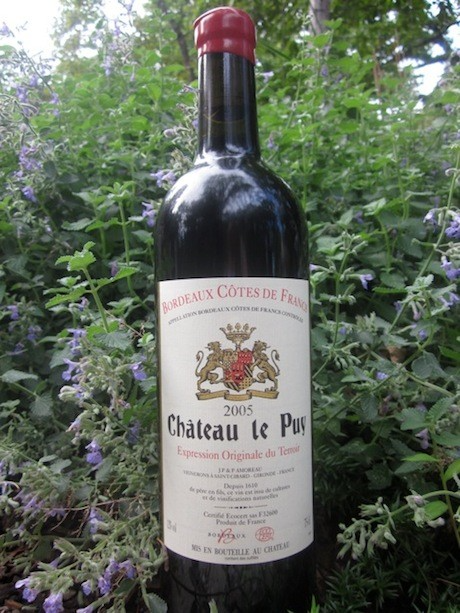Château le Puy 2005

Mon 19 Sep 2011

Château le Puy 2005
Available at Acker Merrall & Condit
Retail cost: approximately $39
French Wines: The Road Less Traveled
The American poet Robert Frost famously described taking the road less traveled as having made all the difference. Among today’s makers of French wines, Frost’s hero may be best embodied by Jean-Pierre Amoreau, the biodynamic producer of Château le Puy, in the Côtes de Francs region of Bordeaux.
In fact, if you actually travel the narrow road that connects the legendary communes of Pomerol and St.-Emilion and take a small detrip to the top of the hill, you will find one of the world’s most perfect vineyards. At Château le Puy, every aspect of the vineyard and wine-making philosophy is designed to preserve a natural balance, both in the vineyards through biodynamic methods (think organic plus lunar calendar) and in the cellar, where natural processes are allowed to do their thing with minimal intervention and manipulation on the part of the winemaker. For 15 generations, since 1610, the Amoreau family has been so successful with its natural approach that several of its bottlings do not require the addition of sulfur dioxides, which are de rigueur in combating oxidation in most wineries.
How does balance begin in the vineyard? Consider that 60 percent of the estate is under vine and 40 percent is dedicated to a mix of woodlands, orchards and a lake. This mixture of plant life is crucial to the biodiversity that ensures a healthy population of beneficial insects, which eliminates the need for pesticides by keeping the harmful pests at bay.
Because simply hitting their vines with a dose of chemicals is not an option for biodynamic producers, it is often a question of staying ahead of the curve, being ready for the challenges inherent in every growing season. Château le Puy has a weather station linked to a computer system, so when it rains, fungal diseases can be limited through an organic brew of bouillie bordelaise.
One of the obvious benefits of never using chemical pesticides in the vineyards is that the grapes are harvested with a variety of natural yeasts (aka wild yeasts), which are essential to begin fermentation. Châteaux that use pesticides kill off their own natural yeasts. Grapes without yeast will never become wine, so these producers must add commercially manufactured yeasts in the winery in order to begin fermentation. Wild yeasts are mother nature’s gift to the winemaker—a built-in agent that busily goes about converting the grape’s natural sugars into alcohol. It is almost as if the true destiny of a grape is to become wine, because the essential ingredients are already present in nature.
There is an unmistakable irony here: nearly every winery claims to express its unique terroir, yet nearly all these wineries purchase commercially manufactured yeasts, which by definition are foreign. This should give you some idea about how challenging it is to be a successful biodynamic or organic producer; if it were easy to achieve, then many more would be doing it. It should be noted that not all biodynamic or organic producers have achieved the success of Château le Puy. There is inconsistency in this category in general, but the Amoreau family stands as a beacon to those who would choose environmentally conscious wine of outstanding quality.
Château le Puy 2005 is a dark, completely opaque plum color, with pronounced black cherries, crushed blackberries and dried herbs on the nose. Because of the power of the vintage itself as well as Jean-Pierre’s wine-making style, his 2005 needs to be decanted. I let mine rest for three hours before attempting to really taste. Even after the aeration, there were still ponderous amounts of structure in this wine. The blend alone (85 percent merlot, 14 percent cabernet sauvignon and 1 percent carmenère) does not explain the extraction and depth of the wine. It is as if the wine is so full of life that all its components are bursting through, from its very fine and fresh acidity to the generous amounts of dark fruit to the tannins that are firm but not at all rough. It is a wine that is firing on all cylinders; alive and vibrant, with a range of interesting characteristics.
Serve it with rare filet mignon and good French cheeses, and raise your glass to toast the rewards of taking the road less traveled.